Pepper#
During high school, I worked with the humanoid robot
Pepper made by Softbank Robotics.
Together with my classmate, we prepared Pepper for several smaller events,
programming several games and features from scratch, like:
- A friendly debate/sketch between Pepper and the principal for an informational
event for future students
- A kickoff talk at a workshop about modernizing work environments
- Games for Neu-Ulm spielt, a city-wide event about playing games
Articles#
In 2019, the city of Neu-Ulm had its 150th anniversary
(German newspaper article).
Pepper attended several events during that year, entertaining visitors, posing
for photos, and even
becoming an honorary citizen of Neu-Ulm.
You can find more information in German on the
school homepage.
 Pepper at Neu-Ulm Spielt 2018
Pepper at Neu-Ulm Spielt 2018Books about NAO6#
Background#
Together with three classmates, I wrote a guide about programming the humanoid
robot NAO6 in a collaboration with Technik-LPE.
The plan was to write two books: one about the fundamentals of programming NAO6
and another one for a range of scenarios where NAO6 could be used. We split into
two teams to focus on our respective books, but we still supported each other
when we needed help. By the end of 2019, we completed our books and sent them
to Technik-LPE, who handled the typesetting and publishing.
Results#
You can buy a printed copy in German on the Technik-LPE store:
You can get the e-book for free
on the official Softbank Robotics website.
Other Resources#
There is an article about this project written by Ulrich Eberl in the German
science magazine bild der wissenschaft:
Robotik ist, wenn Schüler Lehrer bilden
My former classmate Melanie wrote an article (in German) that was published in a
local newspaper:
Pfuhler Schüler schreiben Lehrbuch
 Printed NAO books
Printed NAO books




